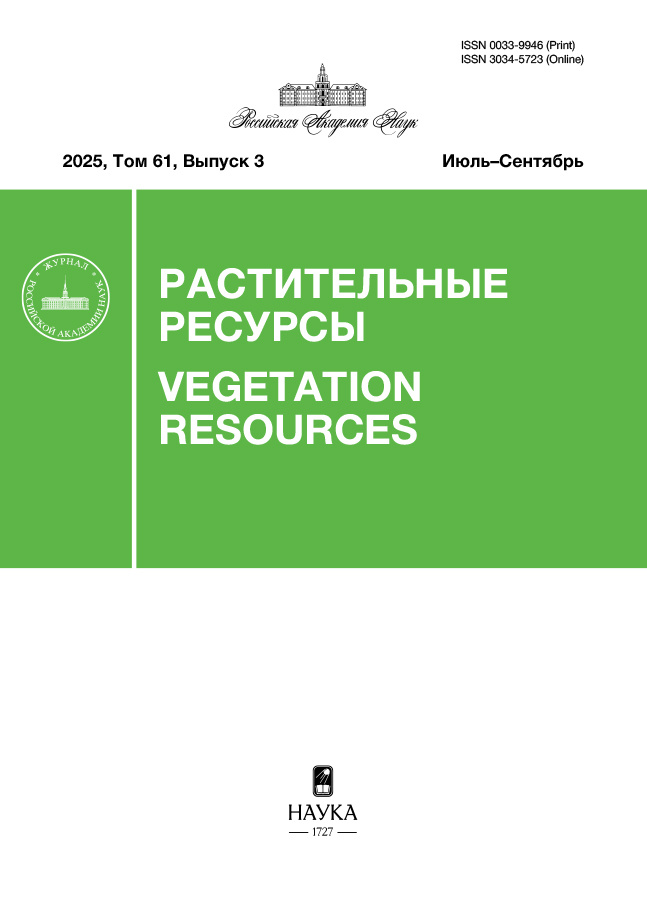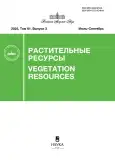СОХРАНЕНИЕ ПРИРОДНЫХ ЦЕНОПОПУЛЯЦИЙ РЕДКИХ И ИСЧЕЗАЮЩИХ ЛЕКАРСТВЕННЫХ ВИДОВ, ВОСТРЕБОВАННЫХ В МЕЖДУНАРОДНОЙ ТОРГОВЛЕ
- Авторы: Кичук Н.И.1, Кичук И.Г.2
-
Учреждения:
- Филиал Федерального центра анализа и оценки техногенного воздействия, научно-исследовательский центр «Красная книга»
- Российский университет дружбы народов им. Патриса Лумумбы
- Выпуск: Том 61, № 3 (2025)
- Страницы: 41-51
- Раздел: РЕСУРСЫ ПОЛЕЗНЫХ РАСТЕНИЙ И РАСТИТЕЛЬНЫХ СООБЩЕСТВ
- URL: https://journal-vniispk.ru/0033-9946/article/view/348578
- DOI: https://doi.org/10.7868/S3034572325030023
- EDN: https://elibrary.ru/yfizac
- ID: 348578
Цитировать
Аннотация
В статье рассматриваются вопросы сохранения природных ценопопуляций ценных видов лекарственных растений, востребованных в международной торговле, не включенных в Приложения СИТЕС. Такими видами являются: сапожниковия растопыренная (Saposhnikovia divaricata (Turcz.) Schischk.), толокнянка обыкновенная (Arctostаphylos иva-иrsi (L.) Spreng), ясенец мохнатоплодный (Dictamnus dasycarpus Turcz.), солодка голая (Glycyrrhíza glаbra L.), окопник лекарственный (Symphytum officinale L.) и веретенник овальнолистный (Atractylodes ovatа L.). Торговля перечисленными видами лекарственных растений регламентирована природоохранными органами. Приведены данные объемов легальной и случаи нелегальной торговли этими видами в Российской Федерации. Установлено негативное влияние многолетней торговли на численность природных ценопопуляций сапожниковии растопыренной и толокнянки обыкновенной. Предложены меры сохранения природных ценопопуляций лекарственных растений, востребованных в торговле. Дана оценка принимаемым на государственном уровне мерам, по защите редких и исчезающих видов лекарственных растений.
Об авторах
Н. И. Кичук
Филиал Федерального центра анализа и оценки техногенного воздействия, научно-исследовательский центр «Красная книга»
Автор, ответственный за переписку.
Email: nata.kichuk.74@mail.ru
Москва, Россия
И. Г. Кичук
Российский университет дружбы народов им. Патриса Лумумбы
Email: nata.kichuk.74@mail.ru
Москва, Россия
Список литературы
- Об утверждении Административного регламента Федеральной службы по надзору в сфере природопользования государственной услуги по выдаче заключения (разрешительного документа) на вывоз с таможенной территории Евразийского экономического союза диких живых животных, отдельных дикорастущих растений и дикорастущего лекарственного сырья, а также редких и находящихся под угрозой исчезновения видов диких животных и дикорастущих растений, включенных в красные книги государств — членов Евразийского экономического союза: приказ Росприроднадзора от 30.03.2020 № 338. http://publication.pravo.gov.ru/Document/View/0001202006160037 (дата обращения 14.03.2025)
- Urbagarova B. M., Shults E. E., Taraskin V. V., Radnaeva L. D., Petrova T. N., Rybalova T. V., Frolova T. S., Pokrovskii A. G., Ganbaatar J. 2020. Chromones and coumarins from Saposhnikovia divaricata (Turcz.) Schischk. Growing in Buryatia and Mongolia and their cytotoxicity. — J. Ethnopharmacol. 261: 112517. https://doi.org/10.1016/j.jep.2019.112517
- Yang M., Wang C., Wang W., Xu J. P., Wang J., Zhang C. H., Li M. 2020. Saposhnikovia divaricata — An ethnopharmacological, phytochemical and pharmacological review. — Chin. J. Integr. Med. 26(11): 873—880. https://doi.org/10.1007/s11655-020-3091-x
- Sun J. B., Gao Y. G., Zang P., Yang H., Zhang L. X. 2013. Mineral elements in root of wild Saposhnikovia divaricata and its rhizosphere soil. — Biol. Trace Elem. Res. 153(1—3): 363—370. https://doi.org/10.1007/s12011-013-9684-x
- Cui Z. 2014. The use of traditional Chinese medicinal materials for Fangfeng and the application of its cultivation and planting technology. — Heilongjiang Medicine J. 27(4): 817—821. http://caod.oriprobe.com/articles/42538933/zhong_yao_cai_fang_feng_de_yong_tu_he_qi_zai_pei_z.htm
- Ahn Y. S., An T. J., Hur M., Yun H. J., Park C. B. 2012. Study for the improvement of seed germination rate on Angelica dahurica, Saposhnikovia divaricata and Bupleurum falcatum. — Korean Soc. Med. Crop. Sci. 2012.05a: 25—26. https://koreascience.kr/article/CFKO201232164230219.pdf
- Kim Y. G., Han S. H., Lee S. H., Kang Y. G., Ahn Y. S., Park C. B. 2010. The study on vegetative propagation of Saposhnikovia divaricata. — Korean Soc. Med. Crop Sci. 2010.10a: 173—174. https://koreascience.kr/article/CFKO201032164227481.pdf
- Heuberger H., Bauer R., Friedl F., Heubl G., Hummelsberger J., Nögel R., Seidenberger P., Torres-Londoño P. 2010. Cultivation and Breeding of Chinese Medicinal Plants in Germany. — Planta Med. 76(17): 1956—1962. https://doi.org/10.1055/s-0030-1250528
- Ishizuka Y., Hayashi K., Moriya A. 1998. Studies on the сultivation of Saposhnikovia divaricata (Turcz.) Schischkin (II): Seasonal variation of root growth, methanol extract and constituent contents. — J. Nat. Med. 52(2): 151—155.
- Morino C., Morita Y., Minami K., Nishidono Y., Nakashima Y., Ozawa R., Takabayashi J., Ono N., Kanaya S., Tamura T., Tezuka Y., Tanaka K. 2018. Oviposition inhibitor in umbelliferous medicinal plants for the common yellow swallowtail (Papilio machaon). — J. Nat. Med. 72(1): 161—165. https://doi.org/10.1007/s11418-017-1124-3
- Nishihara M., Nukui K., Osumi Y., Shiota H. 2018. Quality evaluation of Saposhnikoviae Radix (differences between wild-type and cultivated products). — J. Pharm. Soc. Jpn. 138(4): 571—579. https://doi.org/10.1248/yakushi.17-00208
- Fuchino H., Murase S., Hishida A., Kawahara N. 2021. Simultaneous UHPLC/MS quantitative analysis and comparison of Saposhnikoviae radix constituents in cultivated, wild and commercial products. — J. Nat. Med. 75(3): 499—519. https://doi.org/10.1007/s11418-021-01486-1
- Nishidono Y., Niwa K., Kitajima A., Watanabe S., Tezuka Y., Arita M., Takabayashi J., Tanaka K. 2021. α-Linolenic acid in Papilio machaon larvae regurgitant induces a defensive response in Apiaceae. — Phitochemistry. 188: 112796. https://doi.org/10.1016/j.phytochem.2021.112796
- Банщикова Е. А., Вахнина И. Л., Желибо Т. В. 2020. Saposhnikovia divaricata (Turcz.) Schischkin в степях Юго-Восточного Забайкалья. — Проблемы ботаники Южной Сибири и Монголии. 19(1): 87—92. https://doi.org/10.14258/pbssm.2020018
- Пименов М. Г., Остроумова Т. А. 2012. Зонтичные (Umbelliferae) России. М. 477 с. https://avtor-kmk.ru/pages/showitem.php?id=512
- Королюк А. Ю. 2017. Степи Северного Казахстана — синтаксономическая ревизия. — Растительность России. № 30. С. 61—77. https://elibrary.ru/wjkrdr
- Корсун О. В. 2018. Трансграничный спрос создает угрозу растениям даурских степей. — Степной бюллетень. 51-52: 49—52. http://savesteppe.org/docs/sb51-52.pdf
- Шишмарев В. М., Шишмарева Т. М., Асеева Т. А. 2018. Развитие лекарственного растениеводства на Байкальской природной территории. Улан-Удэ. 152 с.
- Половинкина С. В. 2022. Морфологические особенности и продуктивность Saposhnikovia divaricata (Turcz.) Schischk. в условиях Иркутского района. — В сб.: Климат, экология, сельское хозяйство Евразии: м-лы ХI Междунар. научн-практ. конф. пос. Молодежный. С. 67—74. https://elibrary.ru/pbxpuq
- Цицилин А. Н. 2022. Интродукция Сапожниковии растопыренной (Saposhnikovia divaricata (Turcz.) Schischk.) в ботаническом саду ВИЛАР. — В сб.: Современные проблемы интродукции и сохранения биоразнообразия растений: м-лы Всерос. науч. конф. Воронеж. С. 118—122. https://doi.org/10.17308/978-5-907283-86-2-2022-121-127
- Зубова К. А. 2020. Выращивание и использование лекарственных растений Южно-Сибирского ботанического сада. — В кн.: Молодые ученые в решении актуальных проблем науки: м-лы Х Междунар. научн-практ. конф. Владикавказ. С. 69—71. https://elibrary.ru/rmwizj
- Зубова К. А. 2021. Природные ресурсы Южно-сибирского ботанического сада. — В кн.: Кадастр недвижимости и мониторинг природных ресурсов: научн. труды 6-й Междун. научн.-техн. интернет-конференции. Тула. С. 142—144. https://www.elibrary.ru/uhmiyd
- Елисафенко Т. В., Королюк Е. А., Югрина П. Н., Урбагарова Б. М., Тараскин В. В. 2021. Результаты первичной интродукции Saposhnikovia divaricata (Turcz.) Schischk. в Центральном сибирском ботаническом саду СО РАН. — Растительный мир Азиатской России. 14(4): 293—302. https://doi.org/10.15372/RMAR20210404
- Пельменев В. К. 1985. Семейство Рутовые — Rutaceae. — В кн: Медоносные растения. М.: Россельхозиздат. С. 64.
- Веретенник. https://www.agbina.com/2372/2373/107587 (дата обращения 14.03.2025)
- Курганская С. А. 2004. Окопники. — Биология. № 47. https://bio.1sept.ru/article.php? ID=200404704
- Резенкова О. В. 2003. Изучение влияния экстракта солодки голой на процессы адаптации организма: Автореф. дис. … канд. биол. наук. Ставрополь. 24 с.
- Рыбальченко А. С., Голицын В. П., Комарова Л. Ф. 2002. Исследование экстракции солодкового корня. — Химия растительного сырья. 4: 55—59. https://elibrary.ru/hwinjz
- Saha S., Nosál’ová G., Ghosh D., Flešková D., Capek P., Ray B. 2011. Structural features and in vivo antitussive activity of the water extracted polymer from Glycyrrhiza glabra. — Int. J. Biol. Macromol. 48(4): 634—638. https://doi.org/10.1016/j.ijbiomac.2011.02.003
- Ruetzler K., Fleck M., Nabecker S., Pinter K., Landskron G., Lassnigg A., You J., Sessler D. I. 2013. A randomized, double-blind comparison of licorice versus sugar-water gargle for prevention of postoperative sore throat and postextubation coughing. — Anesth Analg. 117(3): 614—621. https://doi.org/10.1213/ane.0b013e318299a650
- Wang L., Yang R., Yuan B., Liu Y., Liu C. 2015. The antiviral and antimicrobial activities of licorice, a widely-used Chinese herb. — Acta Pharm. Sin. B. 5(4): 310—315. https://doi.org/10.1016/j.apsb.2015.05.005
- Sui X., Yin J., Ren X. 2010. Antiviral effect of diammonium glycyrrhizinate and lithium chloride on cell infection by pseudorabies herpesvirus. — Antiviral Res. 85(2): 346—353. https://doi.org/10.1016/j.antiviral.2009.10.014
- Hosseinzadeh H., Nassiri-Asl M. 2015. Pharmacological effects of Glycyrrhiza spp. and its bioactive constituents: update and review. — Phytother Res. 12(29): 1868—1886. https://doi.org/10.1002/ptr.5487
- Liu R. T., Tang J. T., Zou L. B., Fu J. Y., Lu Q. J. 2011. Liquiritigenin attenuates the learning and memory deficits in an amyloid protein precursor transgenic mouse model and the underlying mechanisms. — Eur. J. Pharmacol. 669(1—3): 76—83. https://doi.org/10.1016/j.ejphar.2011.07.051
- Cinatl J., Morgenstern B., Bauer G., Chandra P., Rabenau H., Doerr H. 2003. Glycyrrhizin, an active component of liquorice roots, and replication of SARS-associated coronavirus. — Lancet. 361(9374): 2045—2046. https://doi.org/10.1016/S0140-6736(03)13615-X
- Wolkerstorfer A., Kurz H., Bachhofner N., Szolar O. 2009. Glycyrrhizin inhibits influenza A virus uptake into the cell. — Antiviral. Res. 83(2): 171—178. https://doi.org/10.1016/j.antiviral.2009.04.012
- Губанов И. А., Киселёва К. В., Новиков В. С., Тихомиров В. Н. 2004. Arctostaphylos uva-ursi (L.) Spreng — Толокнянка обыкновенная. — В кн.: Иллюстрированный определитель растений Средней России. В 3 т. Т. 3: Покрытосеменные. М. С. 19. https://avtor-kmk.ru/main_nature.htm (дата обращения 14.03.2025)
- Толокнянка обыкновенная. https://ru.wikipedia.org/wiki/Толокнянка_обыкновенная (дата обращения 14.03.2025)
- О внесении изменения в раздел 1 «Отдел Покрытосеменные — Angiospermae» Перечня объектов растительного мира, занесенных в Красную книгу Забайкальского края, утвержденного постановлением Правительства Забайкальского края от 16 февраля 2010 года № 52: постановление правительства Забайкальского края от 28 августа 2018 г. № 350. http://docs.cntd.ru/document/550188977 (дата обращения 14.03.2025)
- Из Амурской области в Китай вывезли тонны корней лекарственных растений, позже внесенных в Красную книгу. https://www.amur.life/news/2022/12/06/iz-amurskoy-oblasti-v-kitay-vyvezli-tonny-korney-lekarstvennyh-rasteniy-pozzhe-vnesennyh-v-krasnuyu-knigu (дата обращения 14.03.2025)
- О внесении изменений в постановление Правительства Амурской области от 16 октября 2008 г. № 233: постановление правительства Амурской области от 30 ноября 2022 года № 1163. https://docs.cntd.ru/document/406368631 (дата обращения 14.03.2025)
- The world medicines situation 2011. Traditional medicines: global situation issues and challenges. 2011. Geneva. 14 p. https://iris.who.int/bitstream/handle/10665/78334/WHO_EMP_MIE_2011.2.4_eng.pdf (дата обращения 14.03.2025)
- CITES Convention on international trade in endangered species of wild fauna and flora. Appendices I, II and III valid from 25 May 2024. 2024. 80 p. https://cites.org/sites/default/files/eng/app/2024/E-Appendices-2024-05-25.pdf (дата обращения 14.03.2025)
Дополнительные файлы










